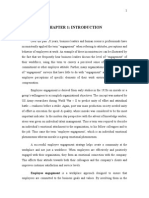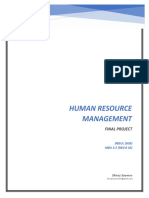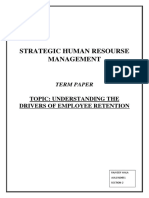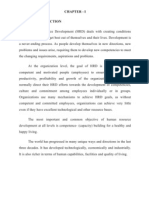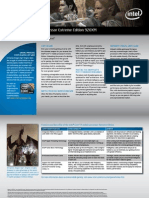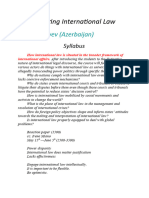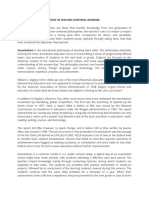025 Hendra B&Meyliana Learning From Google Increasing
025 Hendra B&Meyliana Learning From Google Increasing
Uploaded by
Bridgestone55Copyright:
Available Formats
025 Hendra B&Meyliana Learning From Google Increasing
025 Hendra B&Meyliana Learning From Google Increasing
Uploaded by
Bridgestone55Original Description:
Copyright
Available Formats
Share this document
Did you find this document useful?
Is this content inappropriate?
Copyright:
Available Formats
025 Hendra B&Meyliana Learning From Google Increasing
025 Hendra B&Meyliana Learning From Google Increasing
Uploaded by
Bridgestone55Copyright:
Available Formats
The 2013 IBEA, International Conference on Business, Economics, and Accounting
20 23 March 2013, Bangkok - Thailand
Learning from Google: Increasing the Quality of
Work Life
Hendra Bunyamin
Maranatha Christian University, INDONESIA
Email: hendra.bunyamin@gmail.com
Meyliana
Maranatha Christian University, INDONESIA
Email: meyliana_oey@yahoo.com
Abstract.
Managing human resources effectively has become vital to organizations within
the modern and fast-paced business environment. How to ensure employees are
still committed to the organization and bring them to reach high performance
has turned the focus of human resources management (HRM) at every
organization. Improving the quality of work life becomes one of the HRMs main
goals. Giving attention to the quality of work life can increase motivation and
performance of the employee.
Quality of work life is viewed as a wide-ranging concept, which includes
adequate and fair remuneration, safe and healthy working conditions and social
integration in the work organization that enables an individual to develop and
use all his or her capacities. The definitions also emphasize the good feeling
perceived from the interaction between the individuals and the working
environment.
This article reviews how Google Inc. has been managing human resources
effectively which affects the loyalty of all employees. Moreover, this effective
human resource management has made Google voted as the number one Best
Company to Work for in America. Google utilizes a strategy to create
workplaces and office locations all over the world which are built over sprawling
spaces with providing the employees not only with every possible space for
creativity and innovation, but also ensure that the employees ideas are duly
and uncompromisingly studied, worked on, and acknowledged.
This article concludes that dynamic changes in work environment increase the
quality of work life.
Keywords: Quality of Work Life, Google Inc., and Dynamic Changes in Work
Environment.
INTRODUCTION
A changing business environment as a result of technology changes and an
effect of globalization has shifted human resources paradigms. Most capital owners
treat humans only as one of the production factors in which technology advances,
The 2013 IBEA, International Conference on Business, Economics, and Accounting
20 23 March 2013, Bangkok - Thailand
productivity, and organization growth gain better priorities than human
factors.However, the growth of industries has been a concomitant of the importance
of human resources specialists in business strategists nowadays.The focus has turned
on human resources department at every organization to ensure employees are still
committed to the organization. Well-trainedandcompetentemployees,who are able to
showcase themselves and their organization to the customers in a more effective
manner, help in increasing customer satisfaction and overall clientele, by adding
credibility and reputation to the business. Effective human resourcesplanning and
development practices bring quality and loyal workers who are committed and
passionate about the success of their organization (Mirel, 2008).
Hence, the focus of organizations in order to successfully achieve their
goals these days is how to maintain their employees so that they are satisfied with
their work.Job satisfaction has identified a number of factors, such as reward systems
in work, perceived quality of supervision, working conditions, and individuals
information such as status and seniority, age group, marital status, and years of
experience that cause people to become satisfied or dissatisfied with their job
(Mosadeghrad et al., 2008). In addition to increasing job satisfaction, many
organizations have begun to take a role in developing quality of work life programs.
From a business perspective, quality of work life (QWL) is important since
there is significant evidence demonstrating that the nature of the work environment
is related to satisfaction of employees and work-related behaviors (Greenhaus et al.,
1987). QWL is also found to affect employees work responses in terms of
organizational identification, job satisfaction, job involvement, job effort, job
performance, intention to quit, organizational turnover and personal alienation
(Efraty et al., 1991). We conclude that the role of QWL is very important in achieving
companys goal through improving the quality of their employees works.
This current article reviews how Google Inc. has been managing human
resources effectively which affects the loyalty of all employees. Firstly, keeping the
work-life balance as a mediating construct, it is analyzed whether it leads to employee
satisfaction. Secondly, we would like to prove that dynamic changes in work
environment increase the quality of work life.
DEFINE QUALITY OF WORK LIFE
In principle, quality of work life (QWL) is a management philosophy which
embraces the meaning of job enrichment, which is a way to maintain employees
The 2013 IBEA, International Conference on Business, Economics, and Accounting
20 23 March 2013, Bangkok - Thailand
mental fitness, harmonious industrial relations, and participatory management, and
one of the intervention forms in developing organizations (French et. al, 1990). As a
management philosophy, QWL is a management paradigm about humans, work, and
organizations which handle the work. Moreover, QWL is not only limited to the work
itself, but QWL creates a conducive working environment in which everyone respects
and recognizes one anothers dignity so that employees are motivated and satisfied
when they have done their jobs.
David Walonick (1993) stated QWL is an outgrowth of the human relations
movement. Its goals are to increase productivity, while at the same time improve
employee satisfaction by addressing the emotional needs of workers. The purpose of
QWL management is to create an atmosphere of freedom, participation, and
autonomy in which the worker is a partner in sharing a common objective.
Richard Walton (1985), one of the founders of the QWL approach, identified
eight factors to improve the working life of employees. These are:
1. Fair compensation - Workers should receive sufficient pay and benefits to reach
an acceptable standard of living, and the pay should be similar to others
performing equivalent work.
2. Safety and health - The work environment should not pose any physical or
environmental dangers to workers.
3. Self-development - Management must find ways that enable workers to develop
themselves.
4. Growth and security - Training should be provided to avoid obsolescence, and
workers should be encouraged to make use of their advanced skills.
5. Social integration - Management needs to provide an atmosphere of
encouragement and openness that is free from prejudice.
6. Constitutionalism - Management must recognize that workers have rights, and
workers need to be assured that they have a way to protect those rights.
7. Life space - Management must recognize that employees have life outside of
work, and they should look for ways to minimize the impact of working life on the
workers' families.
8. Social relevance The company maintains high ethics, and acts responsibly with
respect to its products, marketing, and the environment.
The 2013 IBEA, International Conference on Business, Economics, and Accounting
20 23 March 2013, Bangkok - Thailand
In addition, 12 QWL factors working towards the development of employees
for gaining competitive advantage in the market by Sinha (2012) are:
1. Communication: Achieving some level of personal growth may be quite related to
the quality of communication in the organization. Proper communication plays a
pivotal role to achieve results in this priority area.
2. Career Development & Growth: The purpose of career planning as part of an
employee development program is not only to help employees feel like their
employers are investing in them, but also help people manage many aspects of
their lives and deal with the fact that there is a clear promotion track.
3. Organizational Commitment: The relationship of organizational commitment with
work life quality is another aspect of working life that is often investigated by
researchers. Studies have concluded that committed employees remain with the
organization for longer periods of time than those who are less committed and
they have a stronger desire to attend work, and have a more positive attitude
about their employment.
4. Emotional Supervisory Support: It has been suggested that emotional support at
work helps balance work and family roles because it contributes to the
employees energy level.
5. Flexible Work Arrangement: Flexible work arrangements (flextime and
telecommuting) are thought to contribute to job motivation and dedication. They
also enable the employee to use time more efficiently by scheduling activities in a
way that suits his or her situation best.
6. Family-Responsive Culture: in addition to providing flexible work arrangement and
emotional supervisor support, the organizations culture toward combining work
and family roles is at least as important for employees seeking work-family
balance.
7. Employee Motivation: It is important to recognize that individuals have unique
motives for working and quite often it is complex to know what motivates
employees.
8. Organizational Climate: the climate of the organization is divided into affective,
cognitive, and instrumental.
9. Organizational Support: the support is defined as the extent to which employees
perceive that the organization values their contributions and cares about their
The 2013 IBEA, International Conference on Business, Economics, and Accounting
20 23 March 2013, Bangkok - Thailand
wellbeing. This is a key factor in influencing employee commitment to the
organization, job satisfaction, and general quality of work life.
10. Job Satisfaction: this part of feeling enthusiastic or having sense of enjoyment in
ones work.
11. Rewards & Benefits: They emphasized the personal needs are satisfied when
rewards from the organization such as compensation, promotion, recognition and
development meet their expectations.
12. Compensation:a system where people may see a pay increase for lateral moves
that are appropriate for their own development.
Developing employees has become a unique challenge for all human resource
departments at any organization. It has to ensure that the employees are motivated
and committed to the organization with complete integrity and honesty. Tony
Schwartz (2011) mentioned thatthe organization that comes closest to fulfill all the
above criteria is Google and it is a key to their success.
WHAT GOOGLE DO FOR THEIR EMPLOYEES?
Best companies develop their own unique culturesin which employees are
able to say "I trust the people I work for, have pride in what I do, and enjoy the people
I work with."Along with that statement, Googles employee gave a statement as
followed: "Google is a great company and I am very proud to be a part of it. The perks
are extra ordinary and this is the most unique working environment I have ever been
in.The products, ideas, creative minds that we have continue to amaze and inspire
me."
What has Google done so that one takes pride when one works at Googles
company? Googles company is deeply concerned or managing all its employees;
firstly, the managing process starts with a principle of respecting any diversity.
Diversity of its workforces can be seen through the number of communities formed
by Google employees, such as: Black Googlers Network (BGN), woman@Google,
VetNet: Googles Veterans Network, Gayglers: Googles LGBT Network, The Capability
Council, Hispanic Googler Network (HGN) (Google.com 2013).
The second step is that Google company acts as a service provider for the
employees, and treat employees as its customer base treat the employees the same
way you would like them to treat their customer, and the whole paradigm of
customer satisfaction and delivery becomes easy to adopt and adapt. Kuntzhe and
The 2013 IBEA, International Conference on Business, Economics, and Accounting
20 23 March 2013, Bangkok - Thailand
Matulich (2009) stated Google provides its employees a wide range of benefits to
make sure that employees aresatisfied and are loyal to the company. These benefits
include:
1. Free Food (Gourmet Cafeterias & Snack Rooms). Google offers free gourmet
meals to allits employees at any of the company's 11 gourmet cafeterias, at its
Mountain View and New York campuses as well as satellite offices. The rule at
Google is that no staff membershould ever be further away than 100 feet from
a source of food, sovarious snacks, fresh fruit and drinks are a stones throw
away.
2. Onsite Childcare Facilities. Google offers child care service in its Mountain
View campusand also back-up child care to help California parents when their
regularly scheduled childcare falls through.
3. Healthcare Services. Google provides 100% health care coverage for its
employees and theirfamily. In addition on-site physicians and dentists are
available at Mountain View andSeattle campuses.
4. Transportation Services. Google operates free, Wi-Fi-enabled shuttle services
to several San Francisco, East Bay, and South Bay locations.
5. Laundry & Dry Cleaning Services. Employees can do laundry for free in
company washersand dryers and also drop off dry cleaning in the Mountain
View campus.
6. Sport Facilities. Google Mountain View campus contains a swimming pool,
beachvolleyball court, a climbing wall, running trails. Employees can work out
in the gym, attendsubsidized exercise classes, and get a professional massage.
7. Pets Allowed. Google is very unique in its policy that allows employees to bring
their petsto work on condition that pets are reasonably well behaved and
house trained. However, thepet will have to be taken home upon the first
complaint.
8. 20% Creative Time Program. Google encourages all of its engineers to spend
20% of theirwork time on projects that interest them. This program not only
makes engineers enjoy whatthey do and keeps them challenged, but also
provides some good business opportunities forthe company. Gmail, Google
News, Orkut, and AdSense are Google services that were allstarted as
individual projects.
The 2013 IBEA, International Conference on Business, Economics, and Accounting
20 23 March 2013, Bangkok - Thailand
9. Environmentalism. Google is very enthusiastic about environmental
conservation and makes every effort to be as energy efficient as possible.
Google subsidizes employees who buy hybrid or electric cars and who install
solar panels in their homes.
10. Numerous Holidays and Leave Days. Googles employees can get 25 leave days
and 12 holiday days a year. New mothers get 18 weeks of paid maternity leave
and new dads get 7 weeks of paternity leave.
11. Other Services. Google Mountain View campus also includes services such as
hair dressing car wash, and oil change. The company also offers its employees
personal development opportunities like foreign language classes.
What Google has done to facilitate all its employees has made Google voted as
the number one Best Company to Work for in 2007, 2008, 2011, and 2012 based on
Fortunes Magazines (Google.com 2013). Besides 11 benefits offered by Google to its
employees, Google has also designed working environment in corporate headquarters
of Google Googleplex that is located at Mountain View, California. Googleplex is a
unique working place where Googles employees work hard yet have fun at the same
time.
Furthermore, Kuntzhe and Matulich (2009) stated that The Mountain View
headquarter has a college campus-like environment where the virtues of creativity
and innovation are extolled. Google uses its corporate servicescape and corporate
culture and climate to create an informal value-added environment. In Googleplex
peoples workspaces are full of individuality, and the atmosphere is relaxed. There is
neither dress code nor formal daily meetings. All Googles employees can play beach
volleyball, foosball, videogames, pool tables, table tennis, or even roller hockey on the
campus, which makes this young population feel like they are still at a college campus
rather than beingin an office.
Due to the above reasons, Google is the best company to work for.
The Google's success story should give rise to new trends in the organizational culture
and values. It doesn't cost much to provide your employees their freedom and
comfort,on the other hand, what Google has provided for its employees has enabled
Google to gross $209,624 in profit per employee in 2008. This number beatall other
large tech companies in the sector, including big hitters like Microsoft, Apple, Intel
and IBM, and competitor Yahoo! (at $31K per employee) (Kuntzhe and Matulich,
2009).
The 2013 IBEA, International Conference on Business, Economics, and Accounting
20 23 March 2013, Bangkok - Thailand
CONCLUSION
The way taken by Google to facilitate all its employees has made Google the
number one company in the Fortunes list of 100 best companies to work for. The
Google employees hold their pride in saying they work for the best company in the
world; they say proudly that they are working"to organize the world's information and
make it universally accessible and useful" (Murari, 2008). By changing the working
environment into a place like a college and designing a very comforting workplace,
Google has managed to spoil all its employees. Additionally, the way Google designs
dynamic changes in working environment has increased the quality of life from its
employees.
What Google has done may sound ordinary; however, there is not much of
effort to be put in enhancing the employees' pride. But it does a huge impact when it
comes to the talk of the company among aspiring employees. Google employees has
high job satisfaction; this can been from low turnover ratio (4,3%), knowledge
retention, and low absenteeism (Google HR Policies 2013).
REFERENCES
Efraty, D., Sirgy,M. & Claiborne, C. B. (1991) The effects of personal alienation on
organizational identification: quality-of-work life model, Journal of Business
and Psychology, 6(1), pp. 5778.
Greenhaus, J., Bedian, A. &Mossholder, K. (1987) Work experiences, job
performances, and feelings of personal and family well being, Journal of
Vocational Behaviour, 31, pp. 200215.
Gupta, Anurag. (-), Strategic Human Resources Planning at Google Inc, available at
http://www.scribd.com/doc/13286610/Strategic-HR-Planning-at-Google-Inc,
(accessed 11 February 2013).
Kuntzhe, Ronald and Erika Matulich. 2009, Google: Searching For Value, available at
http://www.aabri.com/manuscripts/09429.pdf, (accessed 11 February 2013).
Mirel, Ann. 2008. Development and Strategies for Human Resource Development.
Mosadeghrad, A.M., Ferlie, E., & Rosenberg, D. (2008).Study of the Relationship
between Job Satisfaction, Organizational Commitment and Turnover intention
among Hospital Employees, Health Services Management Research, 21: 211227.
The 2013 IBEA, International Conference on Business, Economics, and Accounting
20 23 March 2013, Bangkok - Thailand
Murari,
Lucky.(2008),
Busyness,
available
at
http://blackmoney.blogspot.com/2008/02/googles-employee-satisfaction_03.html,
(accessed 11 February 2013).
Sinha, Chandranshu. 2012, Factors Affecting Quality of Work Life: Empirical Evidence
from Indian Organizations, Australian Journal of Business and Management
Research,
Vol.1
No.11,
pages
31-40.
Available
at
http://www.ajbmr.com/articlepdf/AJBMR_20_07_4.pdf,
(accessed
11
February 2013).
Schwartz, Tony. (2011), The Twelve Attributes of A Truly Great Place To Work,
available at http://blogs.hbr.org/schwartz/2011/09/the-twelve-attributes-ofa-tru.html, (accessed 11 February 2013).
Walonick, David S. (1993), An Overview of Organizational Leadership and
Management, available at http://www.statpac.org/walonick/leadership.htm,
(accessed 11 February 2013).
Walton, R. E. 1985. "From control to commitment: Transforming workforce
management in the U.S." In The Uneasy Alliance. Clark, R. K., Hayes, R., and
Lorenz, C. (eds.) Boston: Harvard Business School Press.
http://www.scribd.com/doc/28694277/Google-HR-Policies.
You might also like
- Prana HealingDocument17 pagesPrana Healingbalanescu100% (17)
- In Search of The Baroque Flute The Flute Family 1680-1750Document15 pagesIn Search of The Baroque Flute The Flute Family 1680-1750Zacharias Tarpagkos100% (1)
- How To Predict Using Sudarshan ChakraDocument4 pagesHow To Predict Using Sudarshan Chakrajyothishvision0% (1)
- Employee Turnover Influence Factor and CountermeasureDocument19 pagesEmployee Turnover Influence Factor and CountermeasureJavierNo ratings yet
- Work Life Balance - HGSDocument70 pagesWork Life Balance - HGScityNo ratings yet
- Abstract.: Key Words: Quality of Work Life, Job Satisfaction and Work EnvironmentDocument6 pagesAbstract.: Key Words: Quality of Work Life, Job Satisfaction and Work EnvironmentPadmasunNo ratings yet
- Employee RelationsDocument15 pagesEmployee Relationskareena shahNo ratings yet
- Review of LiteratureDocument47 pagesReview of LiteratureAnil BaroliaNo ratings yet
- Employee Engagement RefinedDocument7 pagesEmployee Engagement RefinedKaranja SamuelNo ratings yet
- Work Environment, Social Capital and Their Effect On Satisfaction: Using The SEM-PLS Partial Least Squares ModelDocument10 pagesWork Environment, Social Capital and Their Effect On Satisfaction: Using The SEM-PLS Partial Least Squares ModelEdwin Ramirez AsisNo ratings yet
- Effect of Human Capital On Employee Engagement in Increasing Employee PerformanceDocument7 pagesEffect of Human Capital On Employee Engagement in Increasing Employee PerformanceAJHSSR JournalNo ratings yet
- Work Life Balance of The EmployeesDocument69 pagesWork Life Balance of The Employeesshanu14100% (1)
- Work LifeDocument70 pagesWork LifeAnaghaPuranikNo ratings yet
- PY2022ijstmDocument13 pagesPY2022ijstmSURESH SNo ratings yet
- Literature Review On Employees - EditedDocument7 pagesLiterature Review On Employees - EditedKennedy WashikaNo ratings yet
- Arju PRJCT FinalDocument95 pagesArju PRJCT FinalMuhammed Althaf VKNo ratings yet
- Impact of Training On Employees Performance in Manufacturing IndustriesDocument45 pagesImpact of Training On Employees Performance in Manufacturing IndustriesABDULRAZAQNo ratings yet
- Employee Relations Initiatives and Quality of Work Life: A Study in Power Sector Units Mr. Bijaya Kumar SundarayDocument22 pagesEmployee Relations Initiatives and Quality of Work Life: A Study in Power Sector Units Mr. Bijaya Kumar Sundarayankita mehtaNo ratings yet
- Jo ProjectDocument79 pagesJo ProjectManoj KumarNo ratings yet
- Literature ReviewDocument7 pagesLiterature ReviewMuhammad Umair RajputNo ratings yet
- Human Resource Management: Final ProjectDocument17 pagesHuman Resource Management: Final ProjectCompanion Institute of CommerceNo ratings yet
- Business Research ReportDocument22 pagesBusiness Research ReportSidra AshrafNo ratings yet
- Chapter - 1 Employee RetentionDocument82 pagesChapter - 1 Employee Retentionabi krishNo ratings yet
- SHRM Term PaperDocument11 pagesSHRM Term PapershimoolNo ratings yet
- Eijmrs2041 PDFDocument10 pagesEijmrs2041 PDFMuhammadAdityaWibowoNo ratings yet
- MAM CHRISTINE FRANCISCO DISSERTATION PROPOSAL June 26 2021Document58 pagesMAM CHRISTINE FRANCISCO DISSERTATION PROPOSAL June 26 2021Gohan SayanNo ratings yet
- SHRM Assignment - 4: Submitted by - Diksha Yadav Roll Number - 03512303918Document10 pagesSHRM Assignment - 4: Submitted by - Diksha Yadav Roll Number - 03512303918Diksha YadvNo ratings yet
- Quality of Work Life LBSJiDocument51 pagesQuality of Work Life LBSJiRight ClickNo ratings yet
- MohanDocument31 pagesMohanMukesh kannan MahiNo ratings yet
- RetentionDocument11 pagesRetentionWaqas Uttra100% (1)
- Research Proposal / Synopsis: Managing Employee Retention Through Employees Engagement in An OrganizationDocument11 pagesResearch Proposal / Synopsis: Managing Employee Retention Through Employees Engagement in An OrganizationElegant EmeraldNo ratings yet
- Quality of Work Life Icici InsuranceDocument80 pagesQuality of Work Life Icici Insurancemr copy xeroxNo ratings yet
- Quality of Work Life and Job Satisfaction: A Comparative StudyDocument7 pagesQuality of Work Life and Job Satisfaction: A Comparative Studymohsinab030No ratings yet
- Chapters 1 To 3 Entrepreneurs Perceived CommitmentDocument16 pagesChapters 1 To 3 Entrepreneurs Perceived CommitmentYiel Ruidera PeñamanteNo ratings yet
- A Study On Work Life Balance of Employee in OrganizationDocument9 pagesA Study On Work Life Balance of Employee in OrganizationeswariNo ratings yet
- Enhancing Employee Productivity at NalcoDocument45 pagesEnhancing Employee Productivity at NalcoimadNo ratings yet
- c n c 14 april22Document7 pagesc n c 14 april22fahad afridiNo ratings yet
- Chapter-I 1. Introduction To The Study I Have Undertaken The Project On "Quality of Work Life" As A Part of The PartialDocument46 pagesChapter-I 1. Introduction To The Study I Have Undertaken The Project On "Quality of Work Life" As A Part of The PartialSivarama KrishnanNo ratings yet
- 1.1 A Brief Analysis of The Concept and Components of HPWDocument13 pages1.1 A Brief Analysis of The Concept and Components of HPWNjugi DeusNo ratings yet
- Employee Engagement and Retention Strategies For ODocument9 pagesEmployee Engagement and Retention Strategies For OolufolaglobalconsultNo ratings yet
- HR325Document9 pagesHR325Raches SelvarajNo ratings yet
- Work Life Balance-Study of Public Sector Banks: A Research Report ONDocument85 pagesWork Life Balance-Study of Public Sector Banks: A Research Report ONRaj KumarNo ratings yet
- The T & D Tree by Lerisa RobertsDocument4 pagesThe T & D Tree by Lerisa RobertsLerisa RobertsNo ratings yet
- Employee Engagement ReportDocument19 pagesEmployee Engagement ReportDinesh Kumar100% (1)
- Human Resource TaskDocument10 pagesHuman Resource Taskbonfacematambia001No ratings yet
- Monzo AssignmentDocument13 pagesMonzo Assignmentshazeb aliNo ratings yet
- New Microsoft Office Word DocumentDocument5 pagesNew Microsoft Office Word DocumentManish KediaNo ratings yet
- Building Bridges To Commitment Investigating Employee Retention Practices and Its Influence On Employees' Retention IntentionDocument14 pagesBuilding Bridges To Commitment Investigating Employee Retention Practices and Its Influence On Employees' Retention IntentionPsychology and Education: A Multidisciplinary JournalNo ratings yet
- Project DuroflexDocument89 pagesProject DuroflexElizabeth ThomasNo ratings yet
- Report On Quality of Work LifeDocument83 pagesReport On Quality of Work LiferajivkumarjainNo ratings yet
- Employee EngagementDocument40 pagesEmployee Engagementseema vetal100% (2)
- Review of Literature On Employee EngagementDocument4 pagesReview of Literature On Employee Engagementkarthikeyan JNo ratings yet
- HRA Unit2Document30 pagesHRA Unit2World is GoldNo ratings yet
- Chapter One: General IntroductionDocument65 pagesChapter One: General IntroductionGeorge GrandyNo ratings yet
- Effects of Incentives On Employees ProductivityDocument8 pagesEffects of Incentives On Employees ProductivityInternational Journal of Business Marketing and Management100% (1)
- Human Resources - Ijhrmr - Employee Engagement For - KanimozhiDocument6 pagesHuman Resources - Ijhrmr - Employee Engagement For - KanimozhiTJPRC PublicationsNo ratings yet
- Akhil Final PDFDocument34 pagesAkhil Final PDFKalyan MunduriNo ratings yet
- Assesing The Role of Employee Motivation On Organisation Performance. Acase of Alaf CompanyDocument6 pagesAssesing The Role of Employee Motivation On Organisation Performance. Acase of Alaf CompanySteven MarcusNo ratings yet
- Quality WelfareDocument67 pagesQuality WelfareMahendra JivaNo ratings yet
- Synopsis Report On Quality of Work LifeDocument5 pagesSynopsis Report On Quality of Work LifeManisha MishraNo ratings yet
- Running Head: Management 1Document6 pagesRunning Head: Management 1Essa AshfaqNo ratings yet
- Effect of Employee Relation Practices On Organisational PerformanceDocument64 pagesEffect of Employee Relation Practices On Organisational Performancelynnmelissa022No ratings yet
- Intel® Core™ I7 Mobile Processor Extreme Edition 920XM: The Fastest Laptop Processor On The PlanetDocument2 pagesIntel® Core™ I7 Mobile Processor Extreme Edition 920XM: The Fastest Laptop Processor On The PlanetBridgestone55No ratings yet
- An Investigation of The Factors Affecting Customer Based Brand Equity: A Case of Burger King, SubangDocument6 pagesAn Investigation of The Factors Affecting Customer Based Brand Equity: A Case of Burger King, SubangBridgestone55No ratings yet
- Years Year 1 Year 2 Year 3: Revenue Cost of Sold Products Gross Profit MarginDocument3 pagesYears Year 1 Year 2 Year 3: Revenue Cost of Sold Products Gross Profit MarginBridgestone55No ratings yet
- How To Avoid Exploratory Research: ScholarlycommonsDocument8 pagesHow To Avoid Exploratory Research: ScholarlycommonsBridgestone55No ratings yet
- Business-Level Strategy:: How Do We Compete?Document56 pagesBusiness-Level Strategy:: How Do We Compete?Bridgestone55No ratings yet
- Corporate Strategies I: Moses Acquaah, Ph.D. 377 Bryan Building Phone: (336) 334-5305 Email: Acquaah@uncg - EduDocument34 pagesCorporate Strategies I: Moses Acquaah, Ph.D. 377 Bryan Building Phone: (336) 334-5305 Email: Acquaah@uncg - EduBridgestone55No ratings yet
- Competition in The Computer Industry: Online Versus RetailDocument18 pagesCompetition in The Computer Industry: Online Versus RetailBridgestone55No ratings yet
- Q2 and Q3Document3 pagesQ2 and Q3Bridgestone55100% (1)
- Survey On Satisfaction SamsungDocument4 pagesSurvey On Satisfaction SamsungBridgestone55No ratings yet
- Royal Dutch ShellDocument78 pagesRoyal Dutch ShellBridgestone55No ratings yet
- Issues and Challenges of Women Participation in PoliticsDocument3 pagesIssues and Challenges of Women Participation in PoliticsChan MehboobNo ratings yet
- Waiting For Godot - EssayDocument4 pagesWaiting For Godot - EssayReha Kuldaşlı100% (1)
- Beyond Reality No 2Document64 pagesBeyond Reality No 2andrewmmwilmot100% (1)
- VMI Sample ReportDocument4 pagesVMI Sample Reportm.roseNo ratings yet
- Codifying The Law of State Succession PDFDocument24 pagesCodifying The Law of State Succession PDFShalini Mishra100% (1)
- Business Ethic & Corp GovernanceDocument22 pagesBusiness Ethic & Corp GovernanceSUHANA TABSUMNo ratings yet
- International Politics of RecognitionDocument234 pagesInternational Politics of RecognitionErik RingmarNo ratings yet
- Aaoc ZC111Document13 pagesAaoc ZC111SatheeskumarNo ratings yet
- in The Name ofDocument3 pagesin The Name of033222No ratings yet
- Situating International LawDocument113 pagesSituating International Lawwang.yilinNo ratings yet
- MGT420 (Chap14)Document28 pagesMGT420 (Chap14)azwan ayop100% (1)
- Reinassance Literature - Essay On Shakespeare's SonnetsDocument3 pagesReinassance Literature - Essay On Shakespeare's SonnetsMartina SdNo ratings yet
- Totem Pole Lesson PlanDocument2 pagesTotem Pole Lesson Planapi-340282929No ratings yet
- Thesis Review GuidelinesDocument18 pagesThesis Review GuidelinesAqsha BellaNo ratings yet
- (Interreligious Studies in Theory and Practice) Goshen-Gottstein, Alon - Same God, Other God - Judaism, Hinduism, and The Problem of Idolatry (2015, Palgrave Macmillan) PDFDocument266 pages(Interreligious Studies in Theory and Practice) Goshen-Gottstein, Alon - Same God, Other God - Judaism, Hinduism, and The Problem of Idolatry (2015, Palgrave Macmillan) PDFsalman khanNo ratings yet
- Introduction To Practical LifeDocument24 pagesIntroduction To Practical Lifenabila635493No ratings yet
- Recognizing Visual WordsDocument117 pagesRecognizing Visual WordsBianca Novaki FerrariNo ratings yet
- 7 Reasons Why You Will Never Do Anything Amazing With Your Life - Life Learning - MediumDocument11 pages7 Reasons Why You Will Never Do Anything Amazing With Your Life - Life Learning - MediumMadhur GargNo ratings yet
- Confession Under Indian Evidence ActDocument21 pagesConfession Under Indian Evidence Actmr dharniNo ratings yet
- 543S RDocument29 pages543S RLN ParasuramNo ratings yet
- Genderlect Theory Final DraftDocument5 pagesGenderlect Theory Final Draftapi-317831056100% (1)
- Biophilic Design, A Review of Psychological LiteratureDocument16 pagesBiophilic Design, A Review of Psychological LiteratureArturo Eduardo Villalpando FloresNo ratings yet
- 0. Culture and components of cultureDocument16 pages0. Culture and components of culturehuonglnl45No ratings yet
- Module in Gender and SocietyDocument70 pagesModule in Gender and SocietyJericho MartinNo ratings yet
- RES01 Ch01 Intro ConceptsDocument4 pagesRES01 Ch01 Intro ConceptsMarnelNo ratings yet
- Philosophical Perspectives in TeacherDocument12 pagesPhilosophical Perspectives in TeacherDexter GomezNo ratings yet








